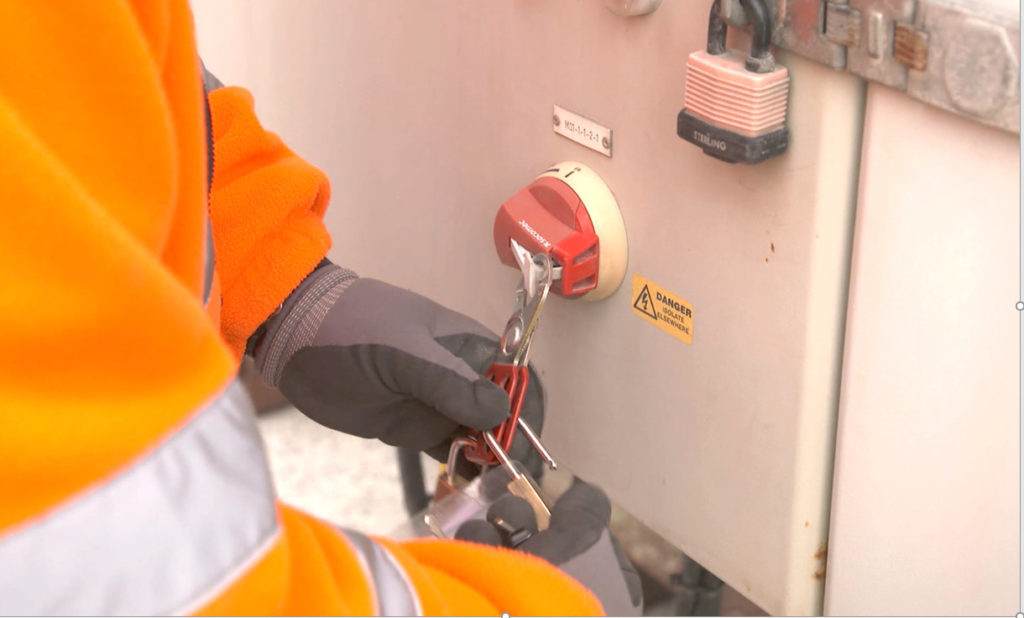
Every day, countless workers engage with machinery, equipment, and processes that carry risks. This calls for the implementation of robust safety protocols and practices to protect employees’ well-being. One such critical safety procedure is the Lock-out, tag-out (LOTO) system.
LOTO has been widely used in industries, but it has proven less than adequate in ensuring machinery doesn’t start accidentally during maintenance work. Organisations are now adopting a more enhanced procedure called lock-out, tag-out, try out (LOTOTO).
This guide explains how LOTOTO improves upon LOTO and how to implement this new system in your organisation.
Key Takeaways
- LOTO is a safety procedure used to prevent machinery from accidentally turning on during maintenance work.
- LOTOTO builds upon LOTO by requiring workers to physically test the equipment before starting maintenance work.
- Properly implementing LOTOTO can reduce the risk of accidents and improve safety compliance.
LOTO, LOTOTO and How They Differ
Lock out, tag out (LOTO) is a safety procedure designed to ensure equipment or machinery is safe when maintenance or repair is being undertaken. It involves two fundamental steps:
- Lock out: Lock out means to physically lock the energy-isolating device. For example, to lock out an electric machine, you might flip the circuit breaker off and put a physical lock or lockout device on the circuit breaker. This will ensure someone can’t accidentally flip the circuit breaker on.
- Tag out: Tag out means to place a physical tag on the energy isolating device, warning not to operate or reenergise the machine. For an electric machine, you might place such a tag at the circuit breaker.
Lock-out, tag-out, try out (LOTOTO) builds upon LOTO and adds a third step:
- Try out: Try out means to physically attempt to turn on or operate the machine to make sure all energy has been isolated. For an electric machine, this can involve trying to turn the circuit breaker on while it’s locked out and attempting to locally turn on the machine in case there are other sources of energy.
Energy sources and the LOTOTO procedure are explained in more detail later in this guide.
What Happens When Isolation Procedures Fail
Many serious accidents involving lock-out tag-out procedures occur because of a failure to check that all necessary isolations have been put in place.
These failures involve a range of issues such as poor communication within work teams, and skill-based human errors. Routine habits such as lockout tag out systems can easily fall prey to missed steps because people are working on autopilot and forget to check.
LOTO in safety perspectives lacks the necessary procedures to ensure it goes through a testing phase, which necessitates the change. Adopting LOTOTO into your lock-out, tag-out system will take your energy isolation system to a new level and help protect your people from common human errors that trigger serious accidents.
Examples of LOTO System Failure
There are numerous examples of what can go wrong when a LOTO system procedure fails:
- A quarry worker performing routine maintenance on a heavy conveyor was pulled into the machine and killed instantly. A failure to ensure the machine could not be turned on resulted in his colleague unknowingly switching it on.
- An electrical engineer performing a repair at height fell and seriously injured himself after receiving a high voltage shock. He had locked the equipment to stop it from turning on, but the control switch had malfunctioned.
- A maintenance worker repairing a steam turbine was blasted with scalding hot steam when a colleague inadvertently switched on the engine.
- A new hire was crushed when he climbed into a hangar blaster to remove a jammed piece of equipment. The machine had not been turned off, so when the part was removed, it began to operate again.
These types of incidents are devastating to those affected. They can result in loss of life, serious injury, costly damage to a business, as well as significant fines.
Health and Safety Courses
Our health and safety courses support legal compliance and effective risk management. They raise awareness of common workplace hazards and teach the fundamentals of safe working.
The Switch from the LOTO System to LOTOTO
LOTO was developed into LOTOTO after a major accident that resulted in numerous fatalities as a result of a faulty control system. While LOTO was followed in this instance, the system was not “tried out”.
Since then many organisations have recognised that the addition of the Try-out step is essential. This step identifies if there are any faults at the point of isolation, and if further work is needed to fix these before beginning repairs or maintenance.
One company making use of LOTOTO is leading British building materials and road work contracting company Tarmac. Across Tarmac’s many branches, all relevant staff are now provided online training on LOTOTO and expected to implement it without fail, where required.
The Mineral Products Association a trade association for asphalt, aggregates, concrete, cement, mortar, lime and silica industries has also formally adopted LOTOTO. Working together with Reece, a safety products supplier, developed a LOTOTO guide explaining how to use this procedures.
What Are the Legal Requirements for LOTOTO?
While following LOTOTO is not a specific legal requirement in the UK, it is still considered best practice. And following LOTOTO will ensure that you are meeting your legal duties under the relevant legislation. This includes:
The Provision and Use of Work Equipment 1998 – Section 19:
Every employer shall ensure that where appropriate work equipment is provided with suitable means to isolate it from all its sources of energy.
Energy and Electricity at Work Regulations 1989 – Regulation 13:
Adequate precautions shall be taken to prevent electrical equipment, which has been made dead in order to prevent danger while work is carried out on or near that equipment, from becoming electrically charged during that work if danger may thereby arise.
In addition to these, under the Health and Safety at Work Act 1974, employers have a general duty to protect anyone from the risks inherent in their work activities. This means that the hazards of energy isolation must be risk assessed and controlled for.
Those at risk, such as craft workers, machine operators, electricians and anyone who services, maintains or repairs equipment on a regular basis, must be provided adequate training. They must be able to recognise this hazard and know what to do to protect themselves from it.
Employers must not only provide this vital training, but they must have evidence that it was provided. This will protect the business in the event that an accident occurs.
What Are Energy Sources?
An energy source is anything that stores energy. The aim of LOTOTO is to ensure that energy sources cannot provide energy to machinery and that they don’t release energy accidentally. This is called energy isolation.
The following are some of the common types of energy sources present in workplaces.
Electrical
Electrical energy is utilised in nearly all workplace machinery and equipment. Accidental electrical discharge can result in the unexpected re-start of equipment, contact with live wires, uninsulated power socket outlets, and faulty switchboards.
Kinetic
Kinetic energy sources include types of equipment that move. This includes conveyor belts, flywheels, and rollers. Common hazards of kinetic energy sources include getting caught in, caught on, and caught between machines.
Chemical
Chemical reactions such as synthesis or decomposition are a common part of industrial manufacturing. Uncontrolled reactions can result in fires, the release of gas, and explosions. These can be catastrophic to worker safety and property.
Thermal
Thermal energy is when excessive heat or cold is stored in equipment or machinery. It includes steam or hot water systems. This can lead to third-degree burns and disability.
Gravity
Gravity can store large amounts of potential energy that must be isolated. An example is a heavy lorry parked on an incline that is being unloaded. Wheel chocks hold the stored energy in the lorry in place, but if they are removed the lorry could roll resulting in a serious accident or injury.
Pneumatic
Machinery powered by compressed air or gas is an example of a pneumatic energy source. Equipment such drive motors, pneumatic cylinders, and grinders store lethal amounts of destructive potential.
Hydraulic
Hydraulic energy is mainly generated by high-pressure fluids stored in industrial equipment such as forklifts, cutters, and pumps. Coming into the path of escaping hot hydraulic oil due to poor isolation and safety practices can cause immense harm to the recipient.

What Does LOTOTO Involve?
LOTOTO is a nine-step process that must be performed in an orderly sequence. This ensures all hazardous equipment is safely isolated and rendered inoperative. The nine steps are:
1. Prepare
Before shutting down any equipment, the authorised person reviews the work order and gives a pre-job briefing to workers operating or around the equipment. This includes reviewing the equipment and conducting risk assessment of the process. Then the person must complete associated paperwork or a permit to work.
2. Notify
The responsible person notifies all individuals affected by isolation procedure. This can be done via radio or other suitable communication methods. The person must:
- Notify that equipment will be isolated
- Advise them to stay clear
- Instruct them not to turn on the equipment
3. Turn Off
Using the manufacturer guidelines, the authorised person methodically shuts down and de-energises the equipment. This must be done in an orderly manner to avoid additional hazards.
4. Isolation
The person isolates the equipment from hazardous energy using the designed isolation points. This also includes isolating secondary energy sources that could compromise the isolation procedure. If there are any electrical defects, the person must isolate the machine using its energy isolation devices, not its controls.
5. Apply Locks
Each isolation device is locked and tagged. The golden rule is “one lock, one person, one energy source”. This effectively prevents other personnel from accidentally re-energising the equipment. An information tag accompanies each lock to notify workers about the equipment status. An alternative method and information tag must be used for energy sources that are unable to be locked out.
6. Maintaining Zero Energy State
This involves controlling all hazardous energy at zero state, so the equipment is rendered safe for maintenance. The authorised person ensures no energy remains or reaccumulates in the machine, such as tension in springs, pressure in valves, and potential energy due to gravity. Blocking devices can be used to prevent certain parts from moving, such as steel chains.
7. Try-out
Once the hazardous area is cleared of all working personnel, the authorised person must attempt to operate equipment using normal controls. Things to check:
- Has it been re-energised?
- Can it be operated?
Equipment with multiple energy sources or automated sensors must be tried separately from each source. If a fault appears, the authorised person must:
- Shutdown the equipment
- Stop all work
- Address issue to the supervisor
- Report a near hit so an investigation can be completed
8. Perform the Task
The work is performed as planned, complying with the risk assessment. This is conducted in an organised and orderly manner to avoid any accidental reactivation of equipment. In case of stored or re-emergence of energy source, the person must:
- Immediately stop the task.
- Withdraw all personnel
- Implement control measures
- Report a near hit
- Investigate
9. Make Safe, Inspect and Restore
The area is visually inspected to verify that guarding is securely back in place. The person ensures everyone is clear of the equipment and notifies the affected individual that power will be restored. Once that is completed, the person must:
- Remove all personal locks and tagging devices (never remover another worker’s devices)
- Restore all devices to operating position
- Verify they are operating properly
- Notify supervisor that the equipment or process is back in service
- Transfer ownership back to production
Lastly, sign off the paperwork such as isolation registers and permit to work.
Accident Prevention is a Joint Responsibility
There is a lack of proper testing and due process for LOTO from a safety viewpoint. Implementing an effective LOTOTO strategy ensures a safe working system that mitigates health and safety risks from hazardous energy. It protects employers from the high costs and damage to a business that a mishap can bring. Moreover, it will help to avoid unwanted attention from health and safety regulators.
Providing suitable and adequate training is vital to ensuring LOTOTO procedures are not just in place, but are being properly implemented. Our online LOTOTO Training programme is designed to help employers train their staff in simple and complex energy isolation procedures. The programme is certified by the UK’s leading health and safety regulatory bodies and offers interactive modes of learning at the palm of your hand.





















